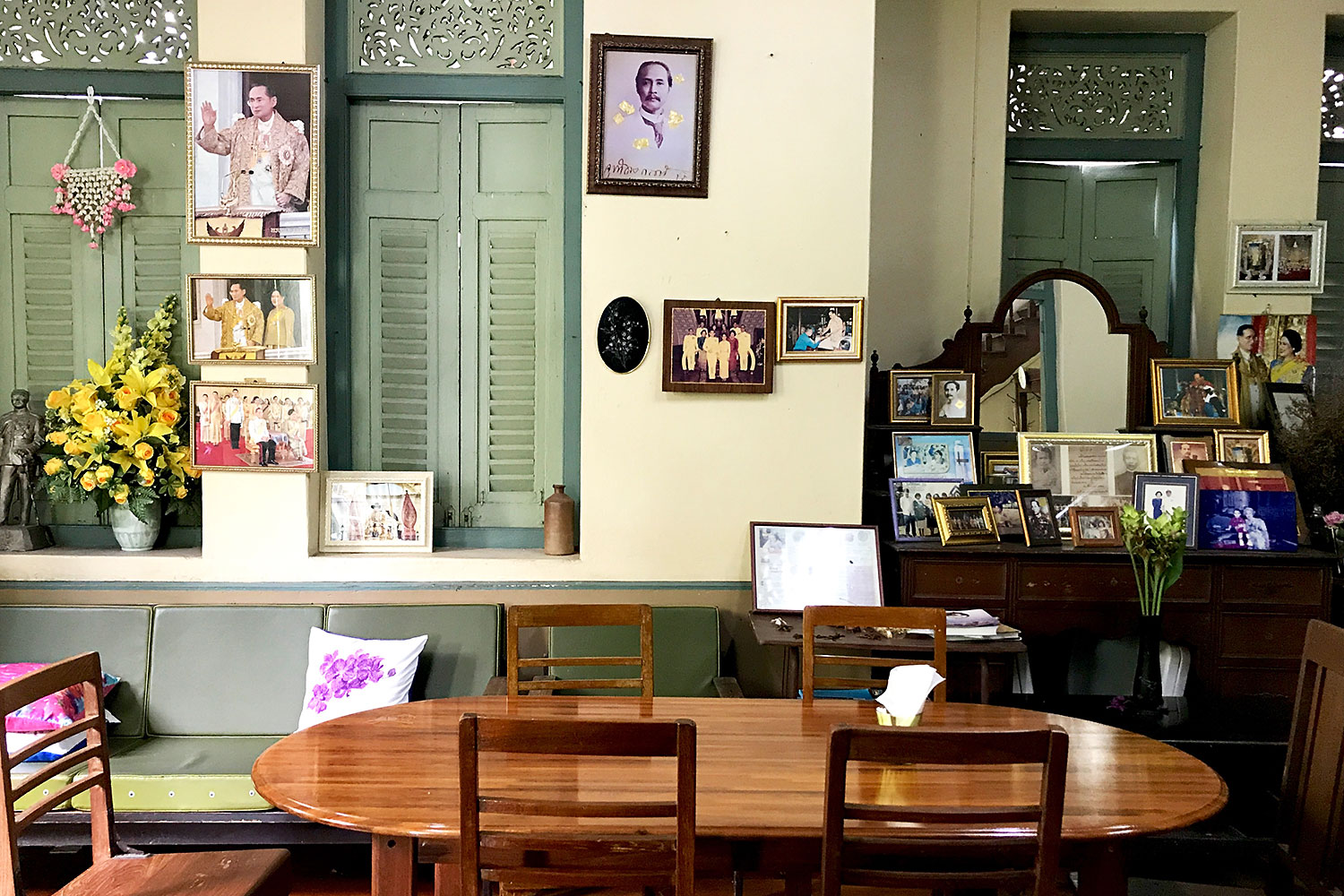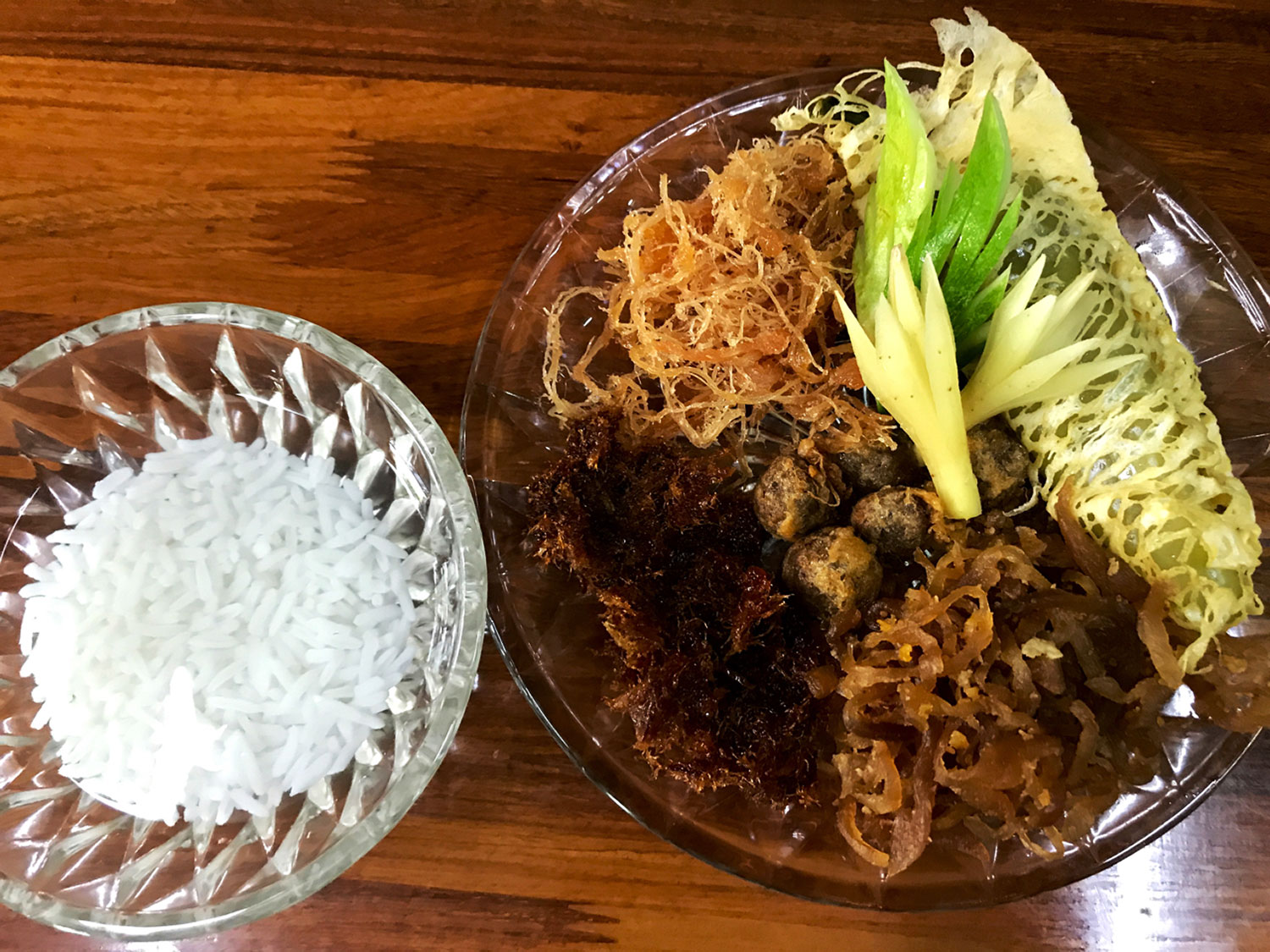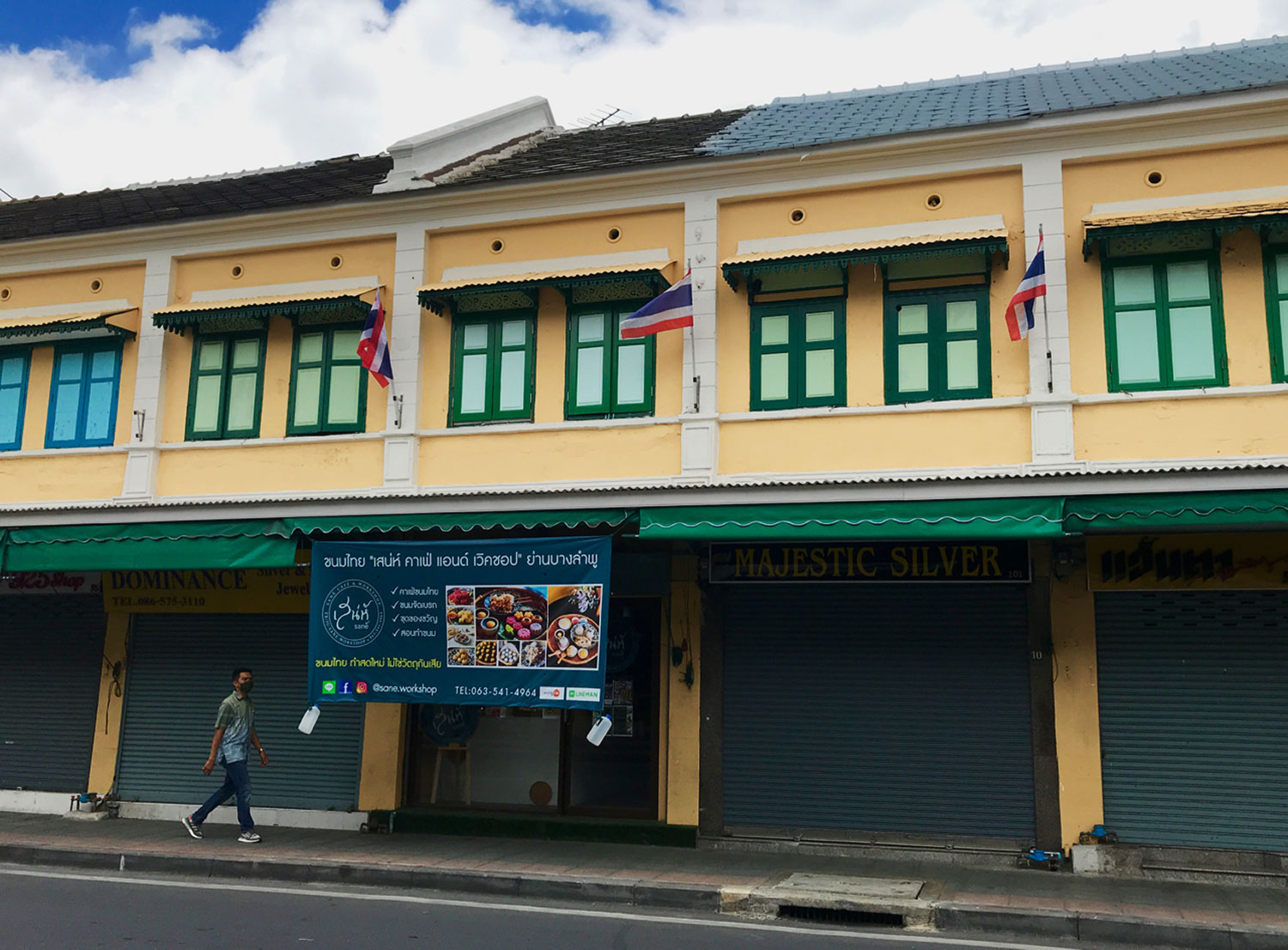Stacks of marigold garlands are placed neatly on tables.



Ban Wannakovit is located in a small alley in Soi damnoen Klang tai and is a short walk to october 14 Monument on ratchadamnoen Klang avenue. Before reaching the building, you will pass a large number of lottery vendors.
Next to the flowers are piles of packed food in containers, each of which has two raw eggs, a portion of sweet sticky rice and a piece of raw pork belly. These items are for sale and vendors call out to worshippers who want to buy the offerings for deities in San Chao Pho Suea, an old Chinese shrine, located on Tanao Road in Bangkok's Phra Nakhon district.
"Do you want oranges? Offering the fruits to Tua Lao Eia [the principal deity] will bring you prosperity," said a vendor as I stopped next to her stall near the entrance gate flanked by two gold-painted tiger sculptures.
San Chao Pho Suea, or the Tiger Deity shrine, is always crowded with worshippers. They come to ask for blessings such as good luck, success or wealth. According to the Bangkok Tourism Division, the shrine was originally built during the period of King Rama III near Bamrung Muang Road. It was relocated to its present location due to road expansion during the reign of King Rama V. The shrine houses various revered deities including Chao Pho Suea, Guan Yu, the God of War, and Guan Yin, Goddess of Mercy.
Before entering the shrine, every visitor needs to pass the Covid-19 screening process. Each visitor must also wear a mask and a staff member from the shrine stands next to the entrance gate to check the body temperature of visitors by using a laser thermometer.
I can't recall the last time I visited the shrine. However this time, the site would be the first stop for my Sunday trip to explore the low-profile Tanao Road, a 1km-long road that starts from the intersection of Bamrung Muang and Fueang Nakhon roads to Ratchadamnoen Klang Avenue and ends at Bowon Niwet Road in Bang Lamphu.


The European-style arch with a female figure holding a torch over her head is located at the t-junction where Phraeng Sapphasat road meets tanao road. the arch is the only remains of the royal mansion of hrh Prince Sanbhasatra Subhakich, a younger brother of King rama V. he was known as the nation’s first filmmaker, the Father of Siamese Cinema.
It was late morning when I arrived at the shrine. More people were still on their way which meant social distancing was almost impossible. The air inside the shrine was full of incense smoke and although I was wearing a PM2.5 protective face mask, I knew I should not stay long after I finished.
Not far from the shrine, I saw shops and restaurants selling yummy food and snacks such as som tam with juicy grilled chicken, phueak tod (deep grief taro chips), phueak hima (sugar-coated taro sticks) and mu phaen (sliced sheets of crispy pork).
There is also a vintage barbershop. It is a non-air conditioned unit that offers service for minimal prices; 60 baht for boys and 80 baht for men. The barber also offers a shaving service after haircuts.
"Come on in. You may not find many of these old-style barbershops like mine in Bangkok nowadays," said the owner who is in his late 60s. He smiled under his face mask as he posed for pictures.
From the barbershop, I strolled further down Tanao street. I tried to walk under the shade of two-storey shophouses to avoid strong sunshine during mid-day. The bright blue sky also had cloudy parts. When I looked around through my polarised sunglasses, I saw the contrast of colours of the blue sky with the light yellow shophouses that had a green touch on each wooden window.
I walked a couple of hundred metres from Chao Pho Suea Shrine to my next stop, Paradai Crafted Chocolate & Cafe. It is known for its bean-to-bar chocolates that have won many international awards since 2018. I ordered their signature iced chocolate. The drink, unfortunately served in a plastic cup with a plastic straw, was topped with dark chocolate flakes. The taste was smooth and not too sweet.
I also ordered a green curry chocolate bar and some bonbons that also had unexpected fillings like miang kham, a traditional bite-size snack. Paradai produces its own chocolate from cacao fruits whose suppliers are farmers who grow cacao trees in Nakhon Si Thammarat. Paradai wants to promote Thainess. The chocolate makers add local spices such as tom kha (a sour and spicy galangal soup) and tom yum, or mixes local fruits like makhaeon (Indian prickly ash) which has a spicy taste and roselle which has a sour taste.


San Chao Pho Suea is one of the sacred Chinese shrines in Bangkok. When you arrive, you can buy a set of 18 incense sticks and a pair of red candles (20 baht) to worship gods and goddesses at the shrine. The staff will give you a guideline or you can look for the numbers 1 to 6 on incense bowls. The numbers indicate steps of praying. Before leaving the shrine, take a look at the top of the entrance gate. You will see the now-defunct address reading Phra Nakhon district and Phra Nakhon province, which today is part of Bangkok. Pictures are not allowed to be taken inside.


These cute images are painted on the walls leading to Fox Hole Art and Shelter Cafe. It’s a small coffee shop which is located opposite Wat Mahannapharam Worawiharn. The cafe owners also love art. They regularly hold free art classes for underprivileged children living in the area and also offer them lunch. The 2nd floor of the shop is a small movie house called Bandai Dam Studio. It used to have art movies on its silver screen but shows have been halted for a while.
Within a half-hour, I finished the green curry chocolate bar, the chocolate drink and three bonbons. I thought to postpone my lunch but I didn't want to miss the opportunity to visit the century-old house of Ban Wannakovit, which is located in Soi Damnoen Klang Tai and is close to the October 14 Monument. I had reserved a table and booked for a set of its famous khao chae, the traditional set of rice soaked in fragrant ice-cold water and served with side dishes. The dish was a tradition of the Mon people before it became famous in the Thai royal courts during the King Rama V period.
Although I am not a fan of khao chae, I wanted to try the traditional version served in Ban Wannakovit. In the past couple of years, you had to book weeks in advance if you wanted to taste the dish. Today, its popularity is not that high.
"Customers arrive," I heard an old man shouting to people while I was passing the gate. The house has a limited car park area and a small garden where herbs, vegetables and chillies are grown. Tall trees also gave shade to the two-storey house.
I took off my shoes and walked toward a non-air conditioned zone. The room is decorated with old wooden furniture and pictures of the family and portraits of King Rama V and His Majesty King Bhumibol Adulyadej and Her Majesty Queen Sirikit The Queen Mother.
It was like a living room that was refurbished to be a dining place. My khao chae set was served shortly. It consisted of white rice, a jug of kradangnga (cananga) flowers infused water and a container of ice cubes. Portions of five side dishes were served on one plate. The items were phrik yuak sod sai (a banana pepper stuffed with seasoned minced pork and wrapped with an egg net), luk kapi (deep-fried balls made of shrimp paste, minced fish and herbs), mu foi (sweet shredded pork), pla foi (sweet shredded fish), chaipow phad kai (stir-fried pickled radish with eggs). The dish was decorated with carved cucumber and krachai (fingerroot).
I took some rice in a small bowl and poured the fragrant water on it. I did not add ice because for me the water was already cold. I was advised to take a small portion of one of the side dishes first and slowly chew it to know the taste which was then followed by a spoonful of soaked rice. The taste was good but it was a bit weird for me to have cold rice soup.


The colourful bonbons are products of Paradai Crafted Chocolate & Cafe. The snacks have more than a dozen flavours such as yuzu orange, mixed berries and miang kham (a wild pepper leaf wrap snack which has slices of lime, chilli, dried shrimp, red onion, roasted peanut, ginger, roasted coconut and sweet sauce). The miang kham bonbon is a dark green with a full scent of miang kham when chewing. The green curry chocolate bar is also surprisingly yummy. While chewing the creamy chocolate, your nose will pick up the smell of the spices. The chocolate won gold at The International Chocolate Awards in Italy in 2019.


These good-looking dishes are served at Ban Wannakovit. One of its famous meals is khao chae, a set of rice soaked in ice-cold water and a side dish. The set is enough for two people. I also like khanom chin sao nam which is a dish of rice noodles served with fresh pineapple, ginger, garlic slices, dried shrimp, fish balls and coconut sauce and khao phad nam phrik makham or fried rice with chilli tamarind shrimp paste served with deep-fried fish, salty egg and fresh vegetables. The restaurant also has snacks like khao tang na tang or rice crackers with dipping sauce and mayongchid loy kaeo or mango plums in ice-cold syrup.
After lunch, I crossed Tanao Road to Baan Ya Hom Zantiis, another century-old house built in a colonial-style during the reign of King Rama VI. The house is well preserved and renovated to be a restaurant plus a traditional massage service.
The restaurant was crowded and all the tables were occupied. I think I was lucky because I was too full already. I wandered inside the building to see the decoration including paintings that reflected the old ambience of the place, samples of ya hom, an aromatic herbal medicine, and aromatic massage oils. When I went out of the house, some customers were waiting for tables outside while those who just finished their lunch were busy taking selfies or group photos in the garden or at the waiting area which is decorated with a built-in shelf imitating an old-style drug store.
With the popularity of the place, I think I will return to taste the food there some other time. I left the restaurant and continued my walk on Tanao Road. I crossed Ratchadamnoen Klang Avenue and passed the four-storey building of Bangkok City Library and an entrance to Khao San Road. My last stop was Sane, a coffee shop that serves many choices of traditional Thai desserts, in Bang Lamphu.
The cafe serves good-looking desserts in a bite-size portion, allowing customers to enjoy various sweets such as bulan dan mek (steamed Thai rice cake with egg yolk drop), piakpoon phuek (taro sweet pudding), khanom chan (layered soft jelly cake) and khanom tom (rice flour dumplings with coconut filling). The prices are justified given the quality of the snacks.
My trip on that fine Sunday ended with a sugar rush but I still bought more sweets to bring back home.

The October 14 Monument was built in 2001 to honour the hundreds of thousands of people who protested against dictatorship at the Democracy Monument and along Ratchadamnoen Road in 1973. The monument is 14m high. The tip of the cone-shaped sculpture is made of a transparent material. The aim is to reflect the sunlight to imply that democracy always shines bright. The site also houses an exhibition, a library, meeting rooms and outdoor space.




Baan Ya Hom Zantiis is located just across from Ban Wannakovit on Tanao Road. The centuryold teak house was built during the period of King Rama VI and it is the property of the Boonyaratawej family, whose ancestors were traditional healers who produced ya hom or an aromatic herbal medicine that can help improve blood circulation. The property has a restaurant, a coffee shop and a souvenir shop on the 1st floor and a traditional Thai massage service on the 2nd floor. The business is run by the fifth generation of the family.




These colourful traditional Thai desserts are available at Sane, a cafe and workshop studio. It is located a short walk from Khao San Road and in a two-storey shophouse. The desserts are sold by piece and by set so customers can sample many choices of sweets that are hard to find today like thong ake, cha mongkud, sampanni and sanae chan. The 2nd floor holds workshops for those who want to know how to make traditional desserts.
TRAVEL INFO
- Chao Pho Suea Shrine is open every day from 6am to 5pm. For more information, call 02-224-2110.
- Paradai Crafted Chocolate & Cafe is open every day from 7am to 8pm. The shop has another outlet on the 3rd floor of the Bangkok Art and Culture Centre in Pathumwan. It is open from 11am to 7pm and closed on Monday. For more information, visit facebook.com/Paradai.Chocolate or call 063-525-5517.
- Ban Wannakovit is open from Tuesday to Sunday from 11am to 3pm. For more details, call 081-922-6611.
- Baan Ya Hom Zantiis is open from Tuesday to Sunday from 9am to 9pm. Visit facebook.com/BAANYAHOMZANTIIS or call 095-764-2768 for booking.
- Sane is open from Tuesday to Sunday from 11am to 7pm. For information visit facebook.com/sane.workshop or call 063-541-4964.

